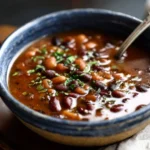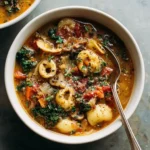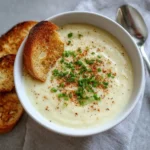Introduction
A Tropical Fruit Layer Cake is a vibrant, colorful, and delicious celebration of sunshine in every bite. Inspired by the lush flavors of the tropics, this cake is a perfect centerpiece for birthdays, parties, or anytime you want to bring a taste of paradise to your table. Combining moist layers of cake with luscious tropical fruits, this dessert is as visually stunning as it is flavorful. Whether you’re craving the tang of pineapple, the creaminess of mango, or the zing of passion fruit, this cake delivers a symphony of tropical flavors that will transport you to a beachside getaway.
The History
The origins of layer cakes can be traced back to 18th-century Europe, where advancements in baking technology allowed for lighter, taller cakes. Over time, these cakes evolved into elaborate creations, especially in the United States during the 19th and 20th centuries. The Tropical Fruit Layer Cake, however, is a more modern invention, reflecting the globalization of food and the growing popularity of exotic fruits in Western baking. As tropical fruits became more accessible and widely enjoyed, bakers began incorporating them into desserts, giving rise to this vibrant, fruity variation of the classic layer cake.
Ingredients Breakdown
The beauty of a Tropical Fruit Layer Cake lies in its balance of textures and flavors. Each ingredient plays a crucial role in creating a moist, flavorful, and stable cake that can support layers of fresh fruit and creamy fillings. The cake layers are typically made from all-purpose flour, sugar, butter or oil, eggs, baking powder, and milk or buttermilk. For the filling, tropical fruits like pineapple, mango, passion fruit, kiwi, and papaya are commonly used, often combined with whipped cream, custard, or a fruit glaze to bind the layers together. Frosting options include buttercream, cream cheese frosting, or even a coconut-flavored whipped cream to complement the tropical theme.
Step-by-Step Recipe
- Prepare the cake layers: Preheat your oven to 350°F (175°C). Grease and flour three 8- or 9-inch round cake pans. In a large bowl, whisk together 2 ½ cups all-purpose flour, 2 ½ tsp baking powder, and ½ tsp salt.
- In a separate bowl, cream together 1 cup unsalted butter and 2 cups granulated sugar until light and fluffy. Beat in 4 large eggs, one at a time, then mix in 2 tsp vanilla extract.
- Gradually alternate adding the dry ingredients and 1 cup milk (or buttermilk) to the butter mixture, beginning and ending with the dry ingredients. Mix until just combined.
- Divide the batter evenly between the prepared pans and bake for 25–30 minutes or until a toothpick inserted in the center comes out clean. Let the cakes cool in the pans for 10 minutes before transferring them to a wire rack to cool completely.
- Prepare the fruit filling: Dice 2 ripe mangoes, 1 cup pineapple chunks, ½ cup passion fruit pulp, and 1 kiwi. Toss the fruits gently with a splash of lime juice to prevent browning.
- Make the frosting: Whip 2 cups heavy cream with ¼ cup powdered sugar and 1 tsp vanilla extract until stiff peaks form. Alternatively, use your favorite buttercream or cream cheese frosting.
- Assemble the cake: Place one cake layer on a serving plate and spread a layer of whipped cream over the top. Arrange a third of the mixed fruit on top. Repeat with the remaining layers, stacking carefully.
- Frost the exterior: Use a spatula or piping bag to frost the top and sides of the assembled cake. Decorate with additional fruit slices and a dusting of shredded coconut, if desired.
- Chill: Refrigerate the cake for at least 1 hour before serving to allow the flavors to meld and the frosting to set.
Tips
- Use room-temperature ingredients for the cake batter to ensure a smooth, lump-free mixture.
- Cool the cake layers completely before assembling to prevent the frosting from melting.
- For a more intense tropical flavor, add a splash of coconut milk or rum to the cake batter or frosting.
- Use a serrated knife to level the cake layers if they have domed tops for a more professional finish.
- When slicing the cake after chilling, use a sharp, warm knife for clean cuts.
- Store the cake in the refrigerator and consume within 2–3 days for optimal freshness and texture.
Variations and Customizations
- Gluten-Free: Substitute the all-purpose flour with a gluten-free flour blend and ensure all other ingredients are certified gluten-free.
- Vegan: Replace the butter with coconut oil or vegan margarine, use plant-based milk, and substitute eggs with flax eggs or applesauce.
- Dairy-Free: Use coconut cream or vegan whipped topping instead of traditional whipped cream or buttercream.
- Flavor Infusions: Add a hint of coconut extract, rum, or tropical fruit purees to the cake layers for extra flavor.
- Layer Options: Try alternating between vanilla and coconut-flavored cake layers for a more complex flavor profile.
- Decorating Ideas: Top with edible flowers, toasted coconut flakes, or tropical-themed cake toppers for a festive look.
- Pantry-Friendly: Use canned tropical fruits in a pinch, but drain them well before use to avoid excess moisture.
Health Considerations and Nutritional Value
While a Tropical Fruit Layer Cake is undeniably indulgent, it can still be enjoyed as part of a balanced diet when consumed in moderation. The cake layers are rich in carbohydrates and fats, primarily from sugar and butter, but the tropical fruits add a wealth of vitamins, antioxidants, and dietary fiber. Mangoes are high in vitamin C and vitamin A, pineapple contains bromelain (an enzyme known for its anti-inflammatory properties), and passion fruit is rich in iron and potassium. To make a healthier version, consider using whole wheat flour, natural sweeteners like honey or maple syrup, and low-fat dairy or plant-based alternatives. Keep in mind that the nutritional value will vary based on the specific ingredients and portion size.
Ingredients
- 2 ½ cups all-purpose flour
- 2 ½ tsp baking powder
- ½ tsp salt
- 1 cup unsalted butter, softened
- 2 cups granulated sugar
- 4 large eggs
- 2 tsp vanilla extract
- 1 cup milk or buttermilk
- 2 ripe mangoes, diced
- 1 cup pineapple chunks
- ½ cup passion fruit pulp
- 1 kiwi, peeled and sliced
- 2 cups heavy cream or whipped topping
- ¼ cup powdered sugar
- 1 tsp vanilla extract
- Lime juice (for tossing fruit)
- Shredded coconut (optional for garnish)
Directions
- Preheat oven to 350°F (175°C). Grease and flour three 8-inch round cake pans.
- In a bowl, combine flour, baking powder, and salt. Set aside.
- Cream butter and sugar together until light and fluffy. Add eggs one at a time, mixing well after each addition. Stir in vanilla extract.
- Alternately add the dry ingredients and milk to the butter mixture, starting and ending with the dry ingredients. Mix until just combined.
- Divide batter evenly between prepared pans. Bake for 25–30 minutes or until a toothpick comes out clean.
- Let cakes cool for 10 minutes before removing from pans to cool completely on wire racks.
- Toss diced fruits with a splash of lime juice. Chill until ready to use.
- Whip heavy cream with powdered sugar and vanilla until stiff peaks form.
- Place one cake layer on a serving plate. Spread a layer of whipped cream, then top with a third of the fruit mixture.
- Repeat with the remaining layers, stacking carefully and frosting the top and sides.
- Garnish with shredded coconut and additional fruit slices if desired.
- Chill for at least 1 hour before serving.
FAQ
Can I make this cake ahead of time?
Yes! This cake can be assembled and refrigerated up to a day in advance. Just add the final fruit garnish right before serving to keep it looking fresh.
Can I freeze the









